Files in this item
Social housing allocation, choice and neighbourhood ethnic mix in England
Item metadata
| dc.contributor.author | Van Ham, Maarten | |
| dc.contributor.author | Manley, David John | |
| dc.date.accessioned | 2016-01-15T13:10:06Z | |
| dc.date.available | 2016-01-15T13:10:06Z | |
| dc.date.issued | 2009-12 | |
| dc.identifier | 4271982 | |
| dc.identifier | 4e3049ac-faa8-449f-9638-03277de2cf76 | |
| dc.identifier | 000283310700002 | |
| dc.identifier | 70449521183 | |
| dc.identifier.citation | Van Ham , M & Manley , D J 2009 , ' Social housing allocation, choice and neighbourhood ethnic mix in England ' , Journal of Housing and the Built Environment , vol. 24 , no. 4 , pp. 407-422 . https://doi.org/10.1007/s10901-009-9158-9 | en |
| dc.identifier.issn | 1573-7772 | |
| dc.identifier.other | ORCID: /0000-0002-2106-0702/work/64697574 | |
| dc.identifier.uri | https://hdl.handle.net/10023/8023 | |
| dc.description.abstract | Driven by a concern about the negative side effects of ethnic concentration neighbourhoods, many European governments aim to create more ethnically and socio-economically mixed neighbourhoods. At the same time, housing policy aims to give tenants more choice in how and where they live. The objectives of these two policies might conflict as offering people choice has the potential to increase self-segregation, especially across ethnic groups. This paper studies the effect of choice-based letting on (self) segregation in housing association stock in England. We analyse whether households who let their property under choice-based letting end up in neighbourhoods with different levels of ethnic concentrations than households who are matched to a dwelling using the traditional allocation system. We focus on how the effect of choice-based letting differs for ethnic minority households and non-ethnic minority households. Using unique data on all lettings made in the housing association sector in England in 2006/2007 and an ordered logit regression model we show that ethnic minority households are more likely to let a property in an ethnic concentration neighbourhood than non-ethnic minority households. Ethnic minorities letting their property under choice-based letting are the most likely to accept a dwelling in an ethnic concentration neighbourhood. | |
| dc.format.extent | 16 | |
| dc.format.extent | 320224 | |
| dc.language.iso | eng | |
| dc.relation.ispartof | Journal of Housing and the Built Environment | en |
| dc.subject | Social housing | en |
| dc.subject | Choice-based letting | en |
| dc.subject | Ethnicity | en |
| dc.subject | Neighbourhood | en |
| dc.subject | Ethnic mix | en |
| dc.subject | Segregation | en |
| dc.subject | England | en |
| dc.subject | Residential preferences | en |
| dc.subject | Racial segregation | en |
| dc.subject | Netherlands | en |
| dc.subject | Britain | en |
| dc.subject | Exclusion | en |
| dc.subject | Mobility | en |
| dc.subject | Context | en |
| dc.subject | Models | en |
| dc.subject | Policy | en |
| dc.subject | H Social Sciences (General) | en |
| dc.subject.lcc | H1 | en |
| dc.title | Social housing allocation, choice and neighbourhood ethnic mix in England | en |
| dc.type | Journal article | en |
| dc.contributor.institution | University of St Andrews. Geography & Sustainable Development | en |
| dc.identifier.doi | https://doi.org/10.1007/s10901-009-9158-9 | |
| dc.description.status | Peer reviewed | en |
This item appears in the following Collection(s)
Items in the St Andrews Research Repository are protected by copyright, with all rights reserved, unless otherwise indicated.

